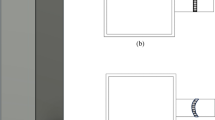Abstract
Empirical criteria (K1–K2 > 0 and η–K3 > 0) for predicting the presence of voids in abandoned shallow underground workings in Donetsk city (Ukraine) located in the zone of intensive weathering are proposed. The voids exist when both inequalities K1–K2 > 0 and η–K3 > 0 are satisfied. The statistical analysis has established that the value of criterion K2 is inversely related to rock quality designation (RQD) and that a decrease in RQD leads to a decrease in K1–K2 and, hence, the probability of the void existence is decreased. It is also established that a statistical parameter η in the left-hand part of inequality η–K3 > 0 decreases according to logarithmic law with increasing standard linear intensity of weathering-induced fractures (P10). When the fracture intensity (P10) increases, the probability of the presence of a void is decreased. The proposed criteria confirm that a thick immediate roof and sandstone layers contribute to the existence of voids of unknown stability. On the other hand, the probability of existence of these voids decreases with increasing thickness of alluvium and total thickness of argillites and sandy shale layers in the rock mass which in turn suggests a decreased probability of void migration and surface subsidence in the future as this has likely already occurred. The use of the proposed criteria in engineering practice is discussed.








Similar content being viewed by others
References
Appert S (2013) Sinkhole kills 5 factory workers in south China. Epoch Times, 22 May 2013
Bell FG, Bullock SET, Halbich TFJ, Lindsay P (2001) Environmental impacts associated with a abandoned mine in the Withbank Coalfield. S Afr Int J Coal Geol 45(2–3):195–216
Borrelli L, Greco R, Gullà G (2007) Weathering grade of rock masses as a predisposing factor to slope instabilities: reconnaissance and control procedures. Geomorphology 87(3):158–175
Culshaw MG, Waltham AC (1987) Natural and artificial cavities as ground engineering hazards. Quar J Eng Geol 20(2):139–150
Day M (1984) Predicting the location of surface collapse within karst depressions: a Jamaican example, in Sinkholes. 1st multidisciplinary conference. Univ. of Wisconsin-Milwaukee, Balkema, Orlando, pp 147–151
Deere DU (1963) Technical description of rock cores for engineering purposes. Rock Mech Eng Geol 1(1):16–22
Dershowitz WS, Herda HH (1992) Interpretation of fracture spacing and intensity. 33rd US Symposium on Rock Mechanics, Santa Fe, 3–5 June 1992. Publ Rotterdam, A A Balkema, pp 757–766
Gokceoglu C, Zorlu K, Ceryan S, Nefeslioglu HA (2009) A comparative study on indirect determination of degree of weathering of granites from some physical and strength parameters by two soft computing techniques. Mater Charact 60(11):1317–1327
Gupta AS, Rao KS (2001) Weathering indices and their applicability for crystalline rocks. Bull Eng Geol Environ 60:201–221
Healy PR, Head JM (2002) Construction over abandoned mine workings. CIRIA Special Publication No, Construction Information and Research Association 32
Helm PR, Davie CT, Glendinning S (2013) Numerical modeling of shallow abandoned mine working subsidence affecting transport infrastructure. Eng Geol 154:6–19
Hill S (2013) Man dies in China sinkhole tragedy caught on camera. Doubtful News, 2 April 2013
Jonsson P (2013) Cause of Florida sinkhole tragedy: human activity or revenge of the karst? The Christian Science Monitor Magazine, 2 March 2013
Karfakis MG, Topuz E (1991) Post mining subsidence abatements in Wyoming abandoned coal mines. Min Sci Technol 12:215–231
Kemmerly PR (1993) Sinkhole hazards and risk assessment in a planning context. J Am Plan Assoc 59(2):221–229
Mauldon M, Dershowitz WS (2000) A multi-dimensional system of fracture abundance. In: Geological Society of America Annual Meeting 32(7), Reno
Mauldon M, Dunne WM, Rohrbaugh JMB (2001) Circular scanlines and circular windows: new tools for characterizing the geometry of fracture traces. J Struct Geol 23(2–3):247–258
Miller RD, Steeples DM (1991) Detecting voids in a 0.6 m coal seam, 7 m depth, using seismic reflection. Geoexploration 28(2):109–119 The Univ. of Kansas, Lawrence
Paganini LA (1988) The causes of sinkholes: man and nature, the culprits. Florida-Geographer 22:20–26 Dept of Geog, Univ of Florida, Gainesville, FL 32611, USA
Palchik V (1989) Evaluate of state of old underground openings. J. Saf Labour ind 10:46–50
Palchik V (1999) Influence of porosity and elastic modulus on uniaxial compressive strength in soft brittle porous sandstones. Rock Mech Rock Eng 32(4):303–309
Palchik V (2000) Prediction of hollows in abandoned underground workings at shallow depth. Geotech Geol Eng 18(1):39–51
Palchik V (2002) Influence of physical characteristics of weak rock mass on height of caved zone over abandoned subsurface coal mines. Environ Geol 42(1):92–101
Palchik V (2012) In situ study of intensity of weathering-induced fractures and methane emission to the atmosphere through these fractures. Eng Geol 125:56–65
Pauwels H, Pettenati M, Greeffie C (2010) The combined effect of abandoned mines and agriculture on groundwater chemistry. J Contam Hydrol 115(1–4):64–78
Ruegsegger LR (2009) Manual for abandoned underground mine inventory and risk assessment. United States Department of Transportation, Federal Highway Administration, Infrastructure Division and the Ohio Department of Transportation, (FHWA IF-99-007)
Siedel H, Pfefferkorn S, Plehwe-Leisen E, Leisen H (2010) Sandstone weathering in tropical climate: results of low-destructive investigations at the temple of Angkor Wat. Cambodia Eng Geol 115(3–4):182–192
Singh KB, Dhar BB (1997) Sinkhole subsidence due to mining. Geotech Geol Eng 15(4):327–341
Smith GJ, Rosenbaum MS (1993) Recent underground investigations of abandoned chalk mine workings beneath Norwich City, Norfolk. Eng Geol 36:67–78
Underwood EE (1970) Quantitative stereology. Addison Wesley, Reading
Waltham AC (1989) Ground Subsidence. Blackie and Son Ltd, London
Whittaker BN, Reddish DJ (1989) Subsidence: occurrence prediction and control. Elsevier, Amsterdam
Zhou W (1997) The formation of sinkholes in karst mining areas in China and some methods of prevention. Environ Geol 31(1–2):50–58
Acknowledgments
The author thanks the anonymous reviewers for the very thorough reading of the paper and valuable suggestions and comments.
Author information
Authors and Affiliations
Corresponding author
Rights and permissions
About this article
Cite this article
Palchik, V. Criteria for Predicting the Presence of Voids in Abandoned Subsurface Mine Workings in Zones of Intensive Weathering. Geotech Geol Eng 32, 987–1000 (2014). https://doi.org/10.1007/s10706-014-9775-2
Received:
Accepted:
Published:
Issue Date:
DOI: https://doi.org/10.1007/s10706-014-9775-2




